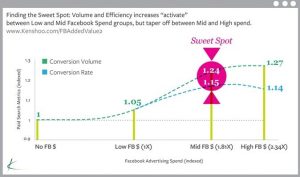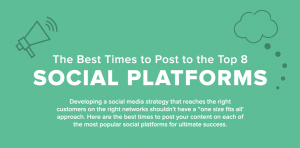— September 20, 2017
A Social Media Marketing Plan for the Fake News Generation
There aren’t too many marketers in the world who don’t have a social media marketing plan in action right now.
I’d like to say that’s a good thing, but it’s (typically) not true.
95%+ of companies have an internet presence that consists of just talking about blog posts on their social accounts. 10-20 times a day, your poor “community” succumb to scrolling past your optimized images and killer titles.
We’re not just pointing fingers. Our social stats are in the same condition. But that’s hopefully changing.
There have been some exciting experiments (by us and others we’ve seen) that are really promising. In today’s post, I’d like to take a look at a few things.
- The Problem: Why the great advice of yesteryear is now terrible.
- The Solution: A few general guidelines to help you break free from fake.
- The Results: There are a few key examples we’ll dig into to see what’s working on three social platforms (Facebook, LinkedIn, and Twitter).
The Problem with Our Social Media Marketing Plans
It’s two words— Fake News.
You’ll notice in the screenshot below, the term didn’t have any interest until a certain political event rocked the U.S. in such a way that ALL media may never recover. Pay special attention to when it became a thing (Nov 2016).
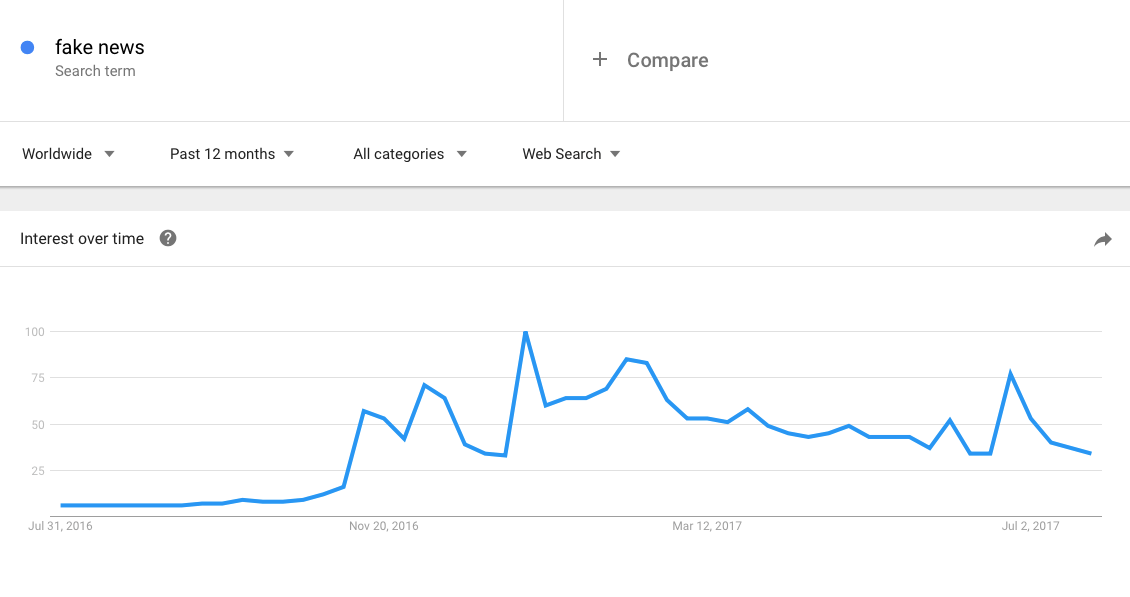
This image reveals the sudden and immediate onset of a problem that has been growing. Anyone who puts out content better be one of two things:
- Real
- Entertaining
…Preferably both.
No matter which “side of the aisle” you find yourself on, reporting on boring topics that turn out to be made up doesn’t get you anywhere. (Not trying to be political here, just making a point about the stuff we all publish.)
If one graph goes up, there’s usually another that goes down.
Take a look at this image (source: Adweek) showing the ratings drop from CNN this year.
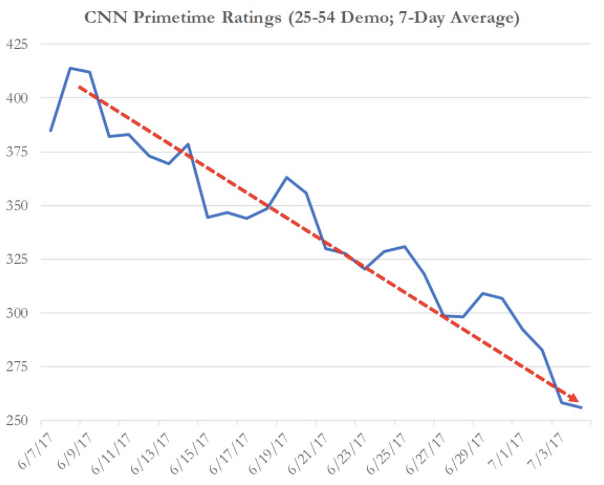
Like I said. If one graph goes up, there’s usually another that goes down.
How does this equate to my social media account? Let’s take a look.
While platforms have been changing up the algorithm and letting fewer people see content, it’s not entirely their fault for our poor engagement.
We’re fake news.
We all start blogs to get targeted traffic, which makes us write about things that people are reading. This is usually based on keyword research. Even this post is optimized for “Social Media Marketing Plan”. You know it, I know it, and the American people know it.
To make matters worse, we put our dubious content out into the social media world. This makes it twice removed from being genuine!
Now, the average business sharing content gets so little engagement it’s just…

The Solution to Our Social Fake News Epidemic
No, we’re not going to stop targeting keywords. It works and we try to give value. This post isn’t about the blogs and articles we write—it’s about creating a (social) media presence that actually accomplishes both parties goals.
Not Dems and Reps, but Businesses and Consumers.
I’ve boiled down the solution into a simple statement.
Invert the value
You write a quality blog post to attract organic traffic. That’s like an equal value ratio. They get content, you get their eyeballs.
Social media (as we all know) is different.
Those are Facebook’s or (insert social platform here)’s eyeballs. And they are not looking for keywords, they are looking for fun, or a job, or conversation. We all know that, but why are our pages space holders and not communities?
Most company social accounts have become space holders and not communities.
Click To Tweet
Because we’re trying to equate these platforms with search engines. And that won’t work.
In order to invert that value, you’ll have to go outside the box burn the box and do things that may seem like they discourage traffic to your site (more on that in a second).
Let’s go ahead and define “the box” with a meme.

Awareness is the first step in the sales funnel, yes. But trust is the only way to bring people down to the next rung. The best way to get people to trust you is to give them something without actually expecting anything in return—even an email.
Social Media Marketing Plan: It’s All About Them (That’s a lie: It’s really about us)
There’s a local weather guy who frequently gets on Facebook Live and starts a weather report only to say something like, “Tune in at 11 for exactly how bad the rain will be”.
If that made you mad, good. You’re starting to get the point.
The bad news is that we all do the same thing with our blog posts. The world is moving too fast to get traffic by showing an image linking to your posts. There are some (and always will be) extremely appealing topics, headlines and other tactics that still help people click.
That said, by and large, this era is over.
Now, we’ll go over a few cases studies (including one of our own) to give you some ideas on how to invert the value.
Fixing the engagement problem isn’t a template, it’s not found in a course. It’s thinking about how to deliver something your audience actually wants to be a part of in a way that makes your brand seem appealing.
Not the other way around. Here are a couple of ideas to get you started.
Case Study One: Have a Pool Party, Buy Some Shorts
What can you do with wood pallets, tie-down straps, and a big tarp?
Hopefully, you’re not thinking bad things because the answer is sell board shorts. A company called “Chubbies Shorts” (specializing in selling men’s swimwear) used an ingenious tactic to drive massive traffic to their site.
Most people love pools, swimming, and sitting in the sun next to the water. It’s great, but if you don’t like all the hassle and maintenance that goes along with pool ownership— you’re out of luck.
Chubbies “solves” this problem with pallets, tie-down straps and a huge tarp. They created a video and a blog detailing the process. All claiming that you can have some summer fun for less than $ 100. The response?
Take a look at the screenshot of the page.
A staggering 1.5 million likes.
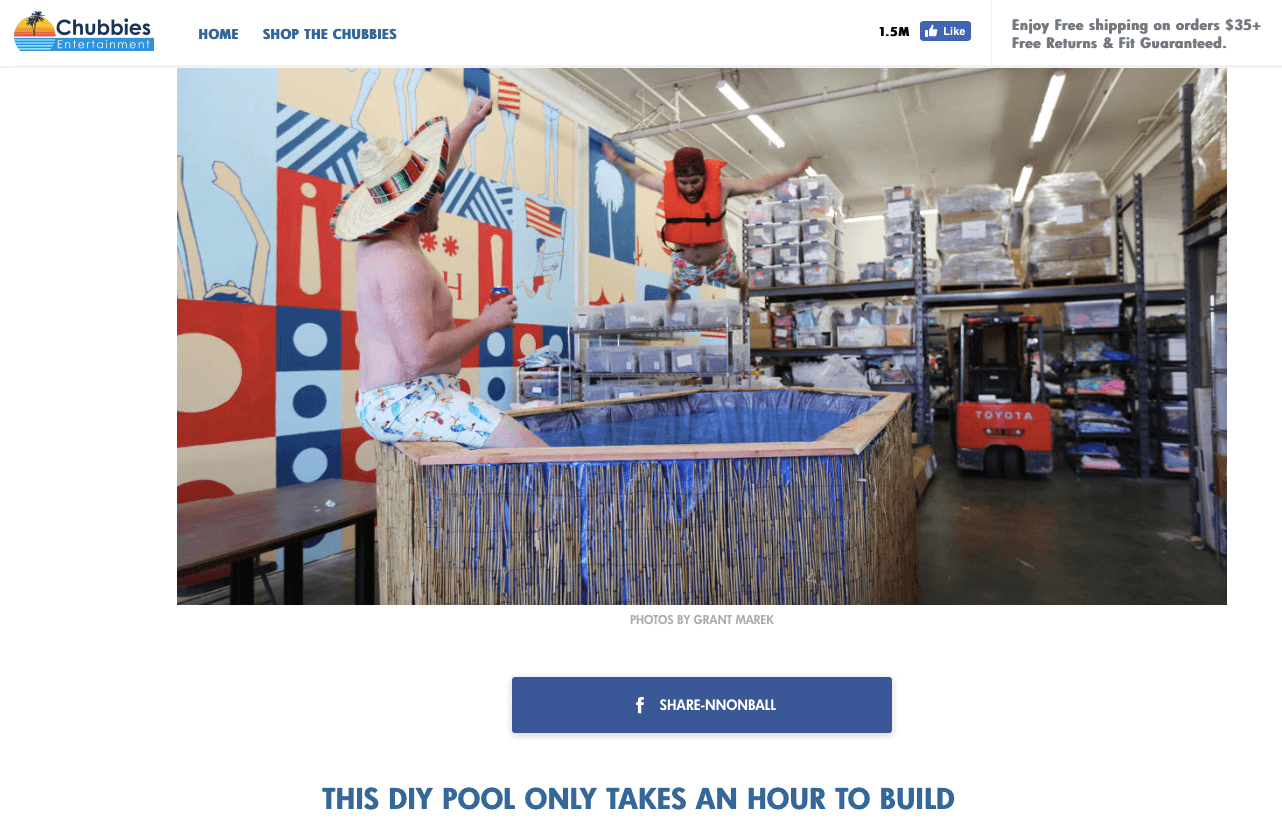
But how about the actual FB post? Take a look at try not to get jealous.
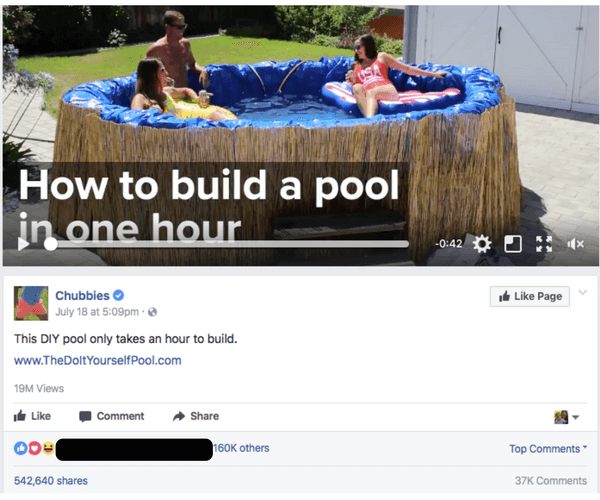
19 million views. Half a million shares and 37k comments!! Still want to post your blogs that get ZERO shares?
We could easily spend a post breaking this down, but let’s just put it in perspective.
There were 111.3 million people that tuned in to the 2017 “Big Game” of football. You know, the one with all the commercials that cost upwards of $ 10 million? Take into account all the die hard fans who use the commercials for what they’re intended for (bathroom breaks) and you may have 50-60 million eyes.
Then, take out those only interested in humor.
Key Takeaway for Us: Take an hour and come up with a list of fun stuff that your prospects will want to watch, bar no ideas. Find the idea(s) that match up best to your brand and do them. It may only cost you $ 100 worth of pallets and tarps to get a comparable audience to the “big game”.
Case Study Two: Free Candy (aka Pure Value Social Posts)
This one is something we’ve tried ourselves from a tip Justin (our Founder) received.
We are reaching out to those in charge of marketing and sales. From VPs to team leads, we want to attract those who want more quality prospects. Obviously, LinkedIn is the primary social platform for us. But, we had the same problem we’re addressing in this post.
Just schedule your blogs in MeetEdgar and the traffic will come right?

Take a look at the average blog post engagement on Justin’s LI. It’s from a guest post we wrote for Authority Labs.
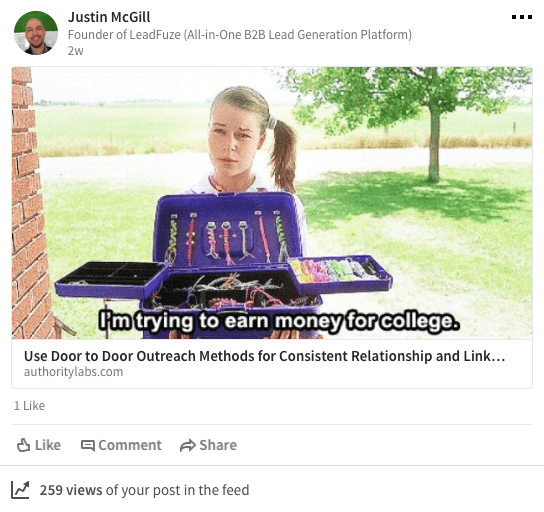
That’s with over 4000 followers on LinkedIn and thousands of connections.
So, here’s the experiment we ran in “four easy steps”.
- Find One of Your Best Blog Posts: What content get the most shares on social already? Pick the best to start with to generate the most interest from your LinkedIn audience. We used our post with 12 alternatives to cold calling.
- Make it Mini: LinkedIn only allows for 1300 characters. This made it really difficult with 12 points, but I had written a script about this post for a whiteboard video already. After minimal edits, we were in business.
- Post it with NO CTA: We put it on LI just for straight value. Gary Vee would call it a Jab. I call it (what should be) a “normal” post.
- Put a Link in the Comments: We still posted a link in the comments, but it didn’t show. Since I posted it as Justin and commented as Justin, it didn’t register as a comment. I’ll do it differently next time, which should have a positive influence on traffic to the site.
The Controllable
We typically publish our full posts on LI Pulse with some decent results (sometimes). Even the full version of the “12 Alternatives” post did really well on Pulse (see screenshots), but it’s still a barrier to entry as opposed to pure value posts. We’ll use it as a controllable.


The Results
Just to be clear about our value, here’s the entirety of the post:
Tired of cold calling? Here are 12 B2B prospecting tactics that don’t require a phone.
1. Twitter Use industry keywords to research and reach out to influencers and decision makers.
2. Facebook Search groups that relate to your target industry and add value to them.
3. LinkedIn Use LinkedIn to research ideal buyers and search groups to find prospects.
4. Quora Quora and other sites like it are great places to set yourself up as an expert by answering industry questions.
5. Email Cold email can be an extremely effective way to warm up leads. Use tools like LeadFuze to automate your lead gen.
6. Referrals Contact your happy clients and ask them to refer you to colleagues. Best to to do this within 30 days.
7. Joint Ventures Friends with a related business? Ask them to do a joint venture and promote each other.
8. Peer Luncheon Chances are someone sells something that compliments your product so invite them to monthly lunches.
9. Snail Mail A good letter can go a long way, even in the digital age.
10. Networks Join a local network and host a meeting to attract local leads.
11. Webinars Do live and answer questions that your prospects have to build trust.
12. Old Leads Dust off those 6 month old leads and try again. Amazing potential returns.
Did it work?
Yep. Within an hour of posting it had more than that plain old update did in two weeks along with two comments and two likes. I “kept the fire burning” by answering every comment.
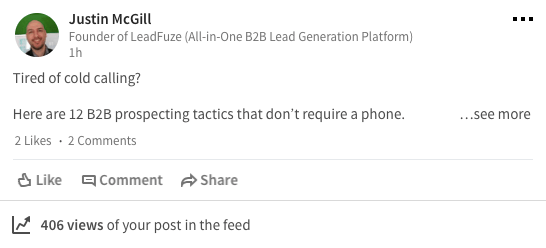
But, here’s the thing. It kept going at that rate (about 300-400/hour).
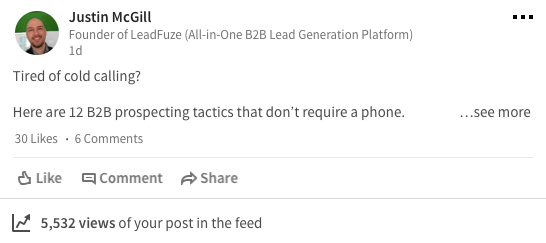
And going.
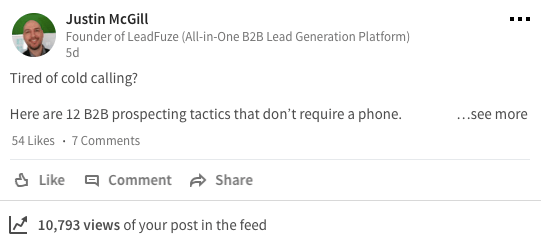
Obviously, engagement can be improved. But for a first run, com’on. As of right now, that post has nearly 12k views. It didn’t slow down for a week.
Which means that instead of posting 5-7 times a day with no engagement, it would be better to post once a week strictly for engagement.
What’s the difference? Let’s get into the key element of inverting the value.
No Opt-In Required
If you’ve been in sales for any amount of time, you know that it takes multiple touch points to get people to recognize your brand. There are lot of ways to do it too. Cold email (our favorite right now), call, text, social, direct mail, and others.
Most businesses have given up on trying to genuinely impress our social audience.
Click To Tweet
Typically, you don’t call someone and ask if they want to be on your email list, do you? Or send a text with that CTA?
Why is it that we use social to attempt (in vain mostly) to draw people to an opt-in page instead of just treating it like the other touch points? Putting yourself out there and waiting to see who’s really interested.
There are people using this strategy to own social. Here’s a great example. It’s the Smart Passive Income podcast. In it Pat Flynn has guests (Shane and Jocelyn Adams) who are using a simple funnel that is doing well for them.
Basically, it’s:
- A no opt-in ad that gives away something completely free (the page has a FB pixel on it).
- They then advertise to that audience on FB with an opt-in offer (since they already got something completely no-obligation).
If you get nothing else from this post, get this: The world of fake news will require us to warm up traffic—for opt-ins.
In an attempt to garner a pipeline, most businesses have given up on trying to genuinely impress our social audience. Simultaneously, audiences are harder to impress.
Neither of these case studies involve an opt-in and both worked to get people seeing and talking. It would seem that people are still social. It’s businesses who aren’t doing it right. If we’re going to use social as a legitimate tactic to garner leads, we’ve got to start and join conversations.
Not shamelessly promote, even our good content.
Otherwise, you’re like the person trying to sell you satellite in the grocery store—you just don’t fit in and everyone knows why you’re there.
What strategies does your social media marketing plan include? Let us know in the comments!
Digital & Social Articles on Business 2 Community
(16)




